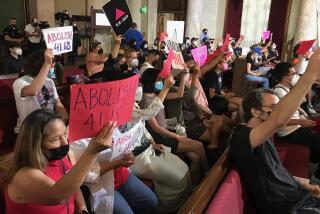Editorial: Billboards, billboards everywhere? No thanks
To hear some Los Angeles leaders tell it, the city has only two options: Either continue to live with some 8,000 ugly, old static billboards forever or replace them by allowing bright, blinking signs pretty much anywhere in the city. In other words, if we want to reduce one blight we have to allow a new one.
But that’s a false choice pushed by the sign industry, which desperately wants to switch to digital billboards because they are far more profitable than traditional signs.
In fact, L.A.’s other option is to limit new digital billboards to the most appropriate commercial neighborhoods — roughly two dozen areas would qualify under a proposal by the city Planning Commission — and still require companies to remove old signs. What’s more, the city could still potentially make money off the deal. It just requires city leaders to reject the industry spin and pass an ordinance that protects Los Angeles’ visual landscape.
In 2009 and again in 2015, the Planning Commission approved reasonable controls that would ban new billboards in roughly 90% of the city. Billboards would be allowed only in specially designated sign districts, such as downtown, Koreatown or Hollywood, where new brightly lit digital billboards would fit the aesthetic.
The city’s poorest neighborhoods are disproportionately cluttered with ugly billboards.
The commission also said that if a company wanted to put up a new digital billboard in a sign district, it would have to remove 10 square feet of old signage for every square foot of new digital signage. That 10:1 ratio would be one of the most aggressive take-down requirements in the country, but not inappropriate for densely populated L.A., where billboards can command top dollar. And companies seeking approval of new signs would also have to chip in for some community beautification, such as landscaping or sidewalk improvements.
But members of the City Council’s Planning and Land Use Committee last week scrapped the Planning Commission’s strict regulations in favor of a policy that would allow companies to put up new billboards pretty much everywhere except residential neighborhoods, subject to the approval of the council. The committee also proposed requiring companies to take down fewer signs, setting the ratio as low as 2:1, if companies pay the city more money.
The committee’s rationale for loosening the proposed regulations? Council members have dollar signs in their eyes. More billboards equal more revenue for the city budget, which can be used to fund city services. (It’s also worth noting that outdoor advertising companies routinely spend tens of thousands of dollars on direct campaign donations and independent expenditures on behalf of elected officials.)
Council members also claim that allowing more billboards will help address social inequities. The city’s poorest neighborhoods are disproportionately cluttered with ugly billboards, they say, and residents should have the option of allowing a new digital billboard in exchange for removing several older ones. If a community doesn’t want the new billboard, the council committee’s plan would let them lobby their council member to reject it.
The committee’s proposal could trigger yet another round of lawsuits from the notoriously litigious sign industry. Several rulings have affirmed Los Angeles’ right to limit new billboards, saying that doing so does not infringe on free speech. But those regulations have to set clear and objective standards for where signs are allowed and where they are banned. The council committee’s proposal would give the council the right to OK or deny an application to put a sign up outside a sign district. That makes the process subjective — not to mention political.
Perhaps it is not surprising that the City Council has been debating the sign ordinance for nearly nine years. The ordinance gets to the heart of some fundamental questions facing Los Angeles as it develops in the years ahead: Who should get to decide what communities look like? How much control should residents have over the built and visual environment? In a perennially cash-strapped city, what are residents willing to trade away to get more money for services?
But in the end, the council must not merely sell out to a powerful industry with a strong lobby, a litigious nature and deep pockets for campaign contributions. Instead, members of the council must think hard about the needs of the city and how to find a fair and progressive balance between the needs of commerce and community.
Follow the Opinion section on Twitter @latimesopinion and Facebook
More to Read
A cure for the common opinion
Get thought-provoking perspectives with our weekly newsletter.
You may occasionally receive promotional content from the Los Angeles Times.






